medium.com/@sonyahallett
This post is about what meltdowns feel like to me, what impacts they’ve had, and what I’m learning about them. Other autistic people may have very different experiences, but if you are autistic yourself, I hope you will find something relatable about my descriptions and illustrations, or something helpful or encouraging in the things I’m learning. If you’re not autistic, I hope this gives you some insight into some aspects of a different way of being, different ways that humans can experience crises, and how your reactions could help or hinder.
----
I’ve been thinking about autistic meltdowns lately, and how little they’re understood. Too much of what society hears about meltdowns, and what gets written, is about autistic kids, their experiences related by parents and professionals. Of course, many autistic people have also talked about their meltdown experiences very eloquently, but as with so many aspects of being autistic, our lived experiences are still very underrepresented in dominant narratives.
I was diagnosed autistic as an adult, at 28. I had always experienced meltdowns and have vivid memories of them happening throughout my childhood, teens and 20s, but I never understood them, and neither did anyone around me. As I got older, these ‘outbursts’ became less and less acceptable and more alarming to others, so I learnt to hide them as much as possible—which was not always.
Now that I understand my meltdowns and their triggers better, I have observed the buildups to usually take two distinct forms: gradual or sudden.
Whatever the type of buildup, I think it is always a reaction to depleting cognitive load, or in other words, too much stuff taking up my brain’s processing capacity, until it’s overwhelmed. In the case of a sudden change, the unexpected thing, which might be fairly trivial, hits me like a tsunami. All my resources are taken up trying to readjust to the new situation — whether it’s making new plans, figuring out how I feel about it, how to react, etc. This doesn’t actually mean that I’m necessarily bad in a crisis. In fact, many of the crises that happen have clear procedures to follow, or they might be things I’ve made contingency plans for. It’s the things I haven’t had a chance to script for or plan out internally that can throw me.
[Click images to enlarge]
Whatever the type of buildup, I think it is always a reaction to depleting cognitive load, or in other words, too much stuff taking up my brain’s processing capacity, until it’s overwhelmed. In the case of a sudden change, the unexpected thing, which might be fairly trivial, hits me like a tsunami. All my resources are taken up trying to readjust to the new situation — whether it’s making new plans, figuring out how I feel about it, how to react, etc. This doesn’t actually mean that I’m necessarily bad in a crisis. In fact, many of the crises that happen have clear procedures to follow, or they might be things I’ve made contingency plans for. It’s the things I haven’t had a chance to script for or plan out internally that can throw me.
The gradual buildup kind can bring lots of different factors into play. Everything that happens in a day, from needing to eat, dress myself, and walk the dog; to projects for work, social demands, other uncertainties or worries, and illness or pain… all of these take up some of my diminishing resources. It can therefore take a fairly trivial thing to bring them all crashing down.
Amidst all this, I have a pretty clear inner voice narrating and observing everything that’s happening, but very diminished in its ability to be in control or make decisions. I can just about make some small judgments about what not to flail at, for example (other people, pets, breakable things), but making more complicated decisions, responding to questions, or even talking can feel overwhelmingly difficult. Trying to chase down my thoughts or words can feel like trying to grab fish in a pond with my bare hands. I need time and quiet to calm down before I can think properly, and every new demand is just prolonging how long that will take.
As an pre-diagnosis adult, my meltdowns were one of the most obvious ‘different’ things about me that I was scared of, and didn’t understand. The feeling of overwhelm can be such that I felt like I would do almost anything to make it stop, even if it meant self-injury or breaking things around me. I also worried that I might hurt other people, and the fear and worry my meltdowns elicited in people when they did see them (and they were often people I felt safe around) made me worry that I was dangerous, or bad, or seriously broken in some way.
These days, I know that I’m running dangerously low on resources when I start finding everything much harder to do and filled with anxiety, including normally very simple tasks like remembering to eat or choosing what to wear in the morning. I also feel it physically: a gradual buildup background hum, like being under high-voltage pylons. The growing buzz also makes me much more sensorily sensitive: noises I’d normally tolerate become increasingly painful, textures freak me out all over the place, my whole body tenses up.
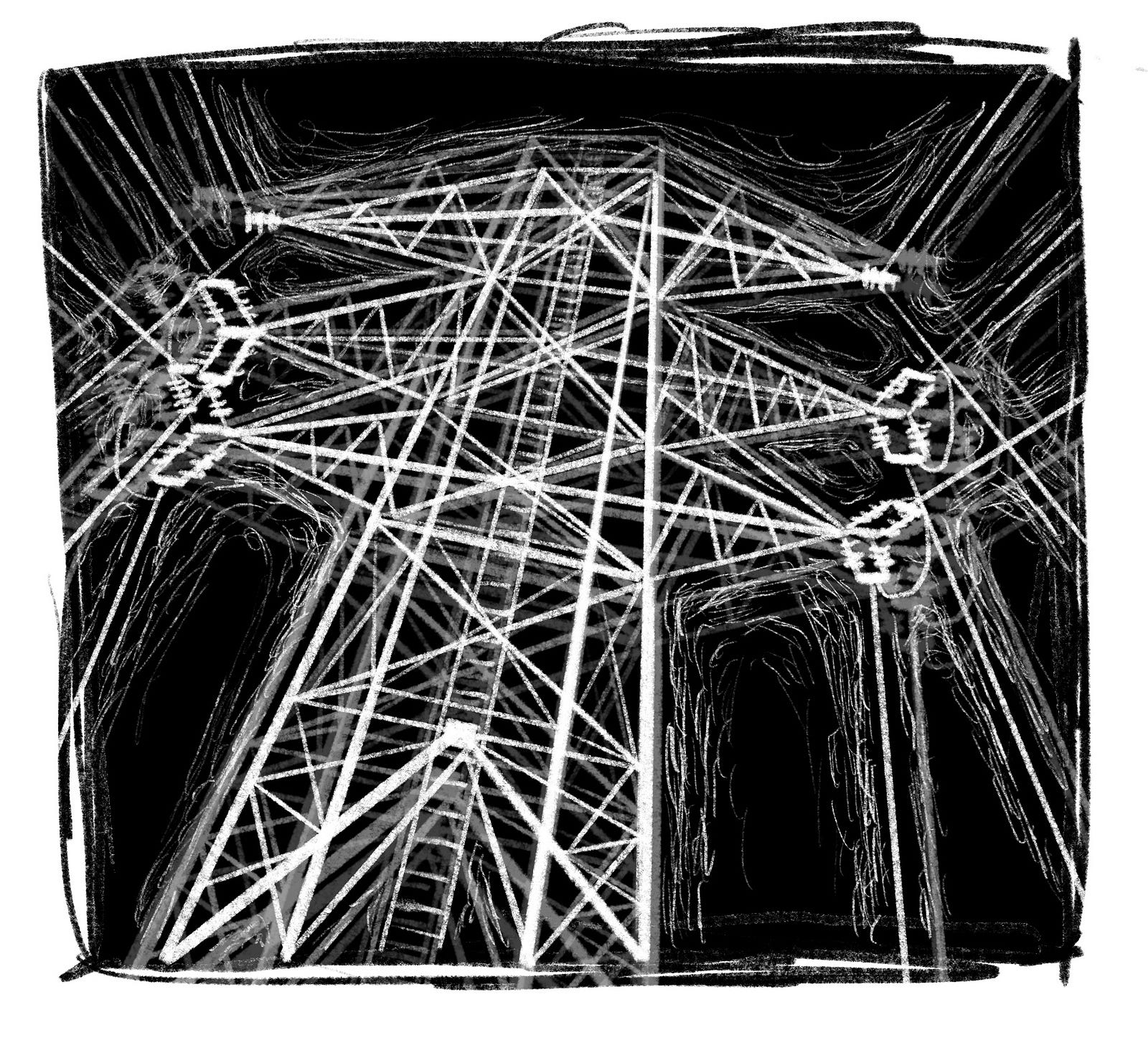 |
| [Image description: a drawing of a white transmission tower on a black background.] |
On days like these, I wake up feeling like my bones have been vibrating in my body all night. The energy makes me want to move about and fidget and shout to shake it out, but also fills me with a deep and draining exhaustion.
In those moments, every additional demand exacerbates and prolongs the pressure. Sensory stuff, decisions I need to make, other people to worry about, or being in public and needing to hide. I might still be able to put off some of the ‘explosion’, but at the expense of things being much more explosive later. The buildup of energy feels like unbearable pressure in my whole body. I need to move or yell or cry. I need to hit things, I need to feel physical pressure or pain so that I can be sure my body isn’t fragmenting.
Amidst all this, I have a pretty clear inner voice narrating and observing everything that’s happening, but very diminished in its ability to be in control or make decisions. I can just about make some small judgments about what not to flail at, for example (other people, pets, breakable things), but making more complicated decisions, responding to questions, or even talking can feel overwhelmingly difficult. Trying to chase down my thoughts or words can feel like trying to grab fish in a pond with my bare hands. I need time and quiet to calm down before I can think properly, and every new demand is just prolonging how long that will take.
As an pre-diagnosis adult, my meltdowns were one of the most obvious ‘different’ things about me that I was scared of, and didn’t understand. The feeling of overwhelm can be such that I felt like I would do almost anything to make it stop, even if it meant self-injury or breaking things around me. I also worried that I might hurt other people, and the fear and worry my meltdowns elicited in people when they did see them (and they were often people I felt safe around) made me worry that I was dangerous, or bad, or seriously broken in some way.
The fact is that while my actions are normal for an autistic person, most non-autistic people don’t know how to react, and may find it alien and alarming due to a lack of understanding. I often think about how people familiar with panic attacks know that they are not an emergency, that they feel worse than they really are, and learn not to panic.
Over the years, I’ve encountered a number of people's reactions to me while I'm in meltdown or near-meltdown: from fear that I was going to be violent or concern that I was having some kind of mental breakdown, to worry that I lacked capacity for making decisions (one ex used to say that those times, and times when I expressed intense joy, made him worry that I didn’t have the ‘mental capacity’ to consent to being in a relationship as an adult). I’ve been told that I am overreacting and need to stop crying, when it’s not in my control, I’ve known people to get angry and tell me I’m ‘acting out’ for attention, and I’ve seen people panic and edge away from me, making me feel like I am some kind of wild animal that they think needs to be contained.
I remember a particularly turbulent time in my teens, going to a Samaritans drop-in, desperate for help with the feelings building up inside me. The well-intentioned volunteer didn’t understand what was happening with me, and my frustration and fear at not being able to communicate, plus her suddenly grabbing my hands in an attempt to comfort me, tipped me over into a full-on meltdown. I remember hiding behind the chair trying to get as far away from her as possible, and hitting the chair, the floor, myself. I remember seeing her back away in alarm and panic, call two more people into the room, who quickly escorted me out of the building.
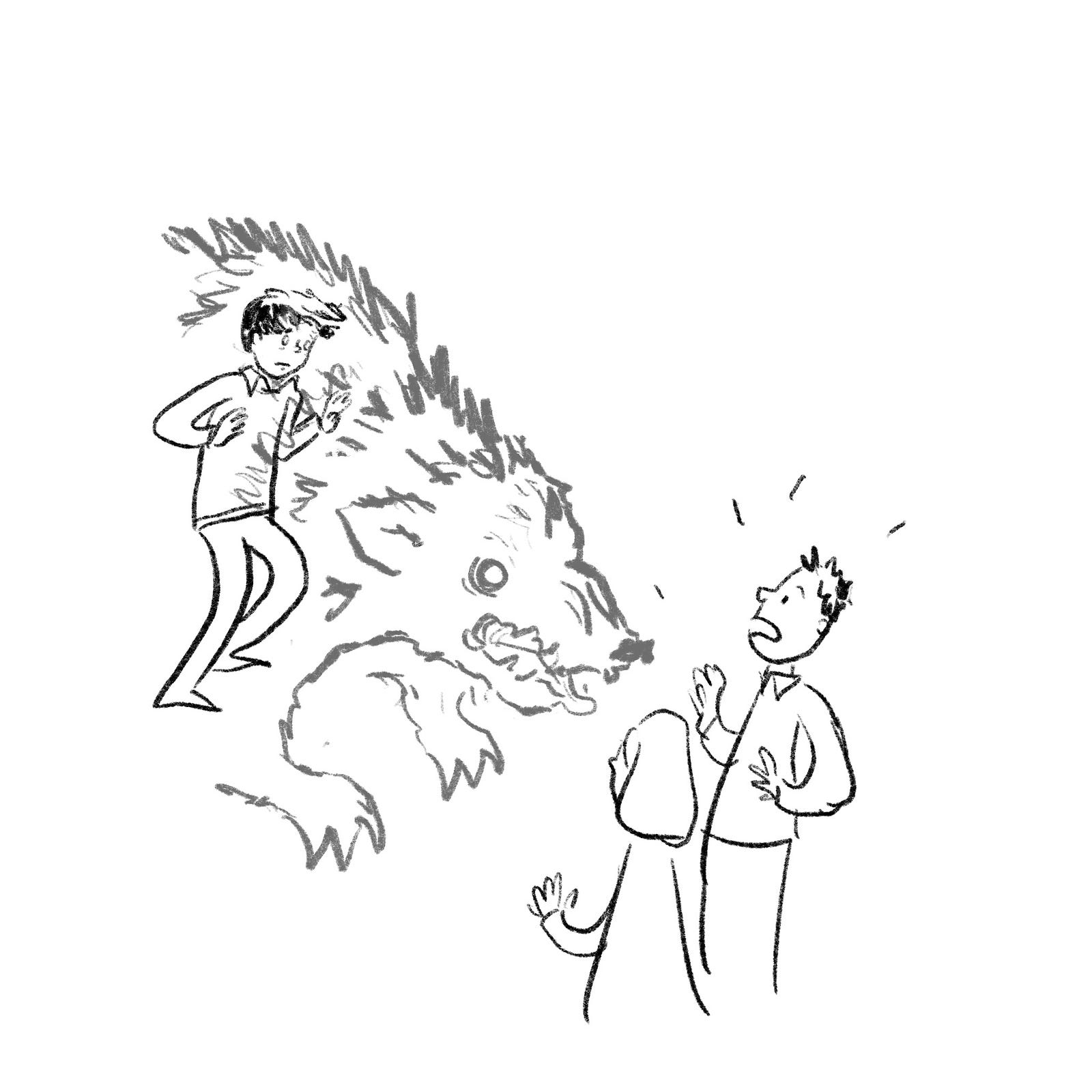 |
| [Image description: a person with a frightened expression inside an angry bear. The bear is snarling at two people in the right bottom corner. The person on the right is also terrified.] |
I remember a particularly turbulent time in my teens, going to a Samaritans drop-in, desperate for help with the feelings building up inside me. The well-intentioned volunteer didn’t understand what was happening with me, and my frustration and fear at not being able to communicate, plus her suddenly grabbing my hands in an attempt to comfort me, tipped me over into a full-on meltdown. I remember hiding behind the chair trying to get as far away from her as possible, and hitting the chair, the floor, myself. I remember seeing her back away in alarm and panic, call two more people into the room, who quickly escorted me out of the building.
Another time, I was in a French lesson at school. It was a hot summer day, the windows were painted shut, the teacher was behind on the exam syllabus, and was making up for it by simultaneously playing us ‘accelerated learning’ tapes, making us finish written work, and sorting out individual paperwork by calling students up to the front. The heat and noise and fractured focus closed in on me more and more. I remember the walls spinning and my breath getting short and panicky. Nothing was making sense and all my senses hurt. I was trying to focus, but my thoughts felt like they were only slowing down, and I couldn’t filter anything out: the unpleasant texture of my school uniform, the tinny tape speakers, another student dropping a pencil…
I felt like a huge force was overwhelming me and I couldn’t stop it: suddenly I got up from my seat, violently, ripped up the paper in front of me in handfuls, and screamed, “THIS IS MAD WE CAN’T WORK LIKE THIS.” I don’t remember anything after that, possibly, except stunned silence and me sobbing. The next day my form tutor said, “I heard you had a funny turn in your French lesson.” I couldn’t explain it, and it wasn’t brought up again asides from by other kids, some of whom would yell, “THIS IS MAD WE CAN’T WORK LIKE THIS!” at me for the rest of my time at that school. I’m still not sure if it was all teasing to be honest, as I think no one else in that class was having a good time that day either.
I felt like a huge force was overwhelming me and I couldn’t stop it: suddenly I got up from my seat, violently, ripped up the paper in front of me in handfuls, and screamed, “THIS IS MAD WE CAN’T WORK LIKE THIS.” I don’t remember anything after that, possibly, except stunned silence and me sobbing. The next day my form tutor said, “I heard you had a funny turn in your French lesson.” I couldn’t explain it, and it wasn’t brought up again asides from by other kids, some of whom would yell, “THIS IS MAD WE CAN’T WORK LIKE THIS!” at me for the rest of my time at that school. I’m still not sure if it was all teasing to be honest, as I think no one else in that class was having a good time that day either.
Some years later, at university, a good friend who used to regularly pop round to my room in the dorms came by after I messaged her saying I was having a tough time. I was under the desk, squeezed in as tightly as I could. I don’t remember what else I was doing but I do remember the expression on her face, and her quickly leaving. We weren’t so close after that.
Learning that I am autistic, and understanding more about what that means for me, made me realise that meltdowns are a normal part of autistic experience. I’m not dangerous, it’s not a sign of some kind of terrible mental deterioration or break from reality — it’s just a response to stress and overwhelm. Don’t get me wrong, meltdowns are still deeply unpleasant, but there is less fear of the unknown attached to them, about what could possibly be happening. I can start to work on learning what my triggers are, when they might be imminent, how to prevent things from escalating, and what I need in those situations.
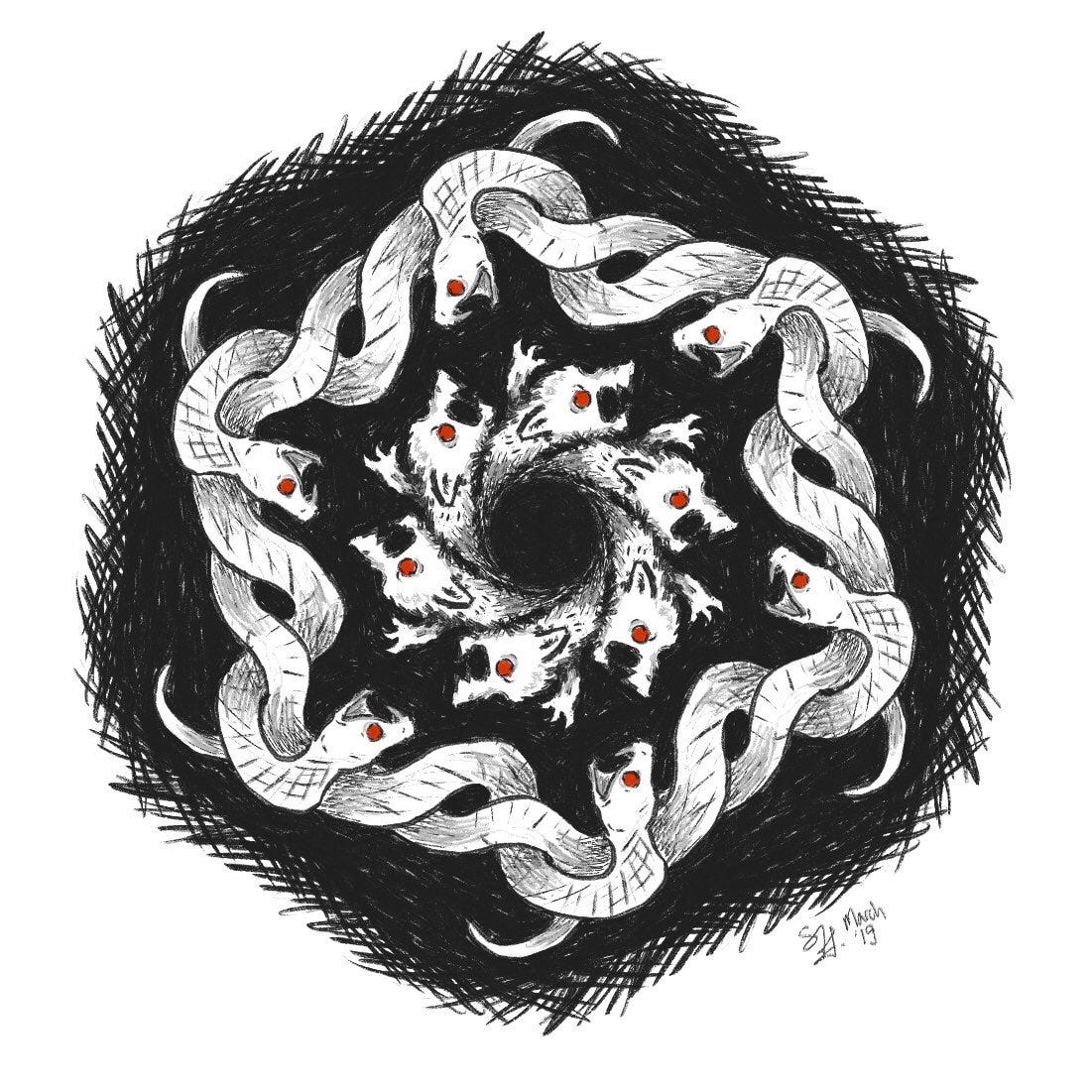 |
| [Image description: a loop of overlapping white ferrets with red eyes surrounded by a larger loop of snakes, their bodies wound together. The snakes and ferrets are snarling at each other.] |
Learning that I am autistic, and understanding more about what that means for me, made me realise that meltdowns are a normal part of autistic experience. I’m not dangerous, it’s not a sign of some kind of terrible mental deterioration or break from reality — it’s just a response to stress and overwhelm. Don’t get me wrong, meltdowns are still deeply unpleasant, but there is less fear of the unknown attached to them, about what could possibly be happening. I can start to work on learning what my triggers are, when they might be imminent, how to prevent things from escalating, and what I need in those situations.
The fact that I can start to figure these things out for myself, with the help of the brilliant autistic community, as well as great allies and mentors, now means that I am also starting to learn to communicate what I need more clearly to others.
Taken in isolation, meltdowns are unpleasant, exhausting, frustrating, sometimes even frightening, but they are also self-limiting. Knowing this, and why they happen, means that to me they really aren’t so much of a big deal in the grand scheme of things any more — I’m going to have them now and then, but that’s ok. The things I still worry about relating to meltdowns are almost all to do with the long-term repercussions of what might happen if I have a meltdown, or start getting close to one, around other people.
Taken in isolation, meltdowns are unpleasant, exhausting, frustrating, sometimes even frightening, but they are also self-limiting. Knowing this, and why they happen, means that to me they really aren’t so much of a big deal in the grand scheme of things any more — I’m going to have them now and then, but that’s ok. The things I still worry about relating to meltdowns are almost all to do with the long-term repercussions of what might happen if I have a meltdown, or start getting close to one, around other people.
It seems like a pretty difficult responsibility that society places on us, as autistic people, to often have to do a lot of clear and coherent educating for our own safety, and to reassure others, just when we’re feeling at our least clear and coherent, and are in most need of reassurance ourselves. There are far too many examples of autistic people being arrested or sectioned, let alone reprimanded or ostracised, for having a reaction to difficulty and stress that is normal to our way of being, but not nearly well enough understood by others.
Following a meltdown that others have witnessed, I’m usually stuck endlessly replaying their reactions, worrying about what they might think, whether they are angry or scared or think less of me, dealing with any consequences that may have come from it. But more and more people are also starting to understand. There are several people in my life now, autistic and non-autistic, who I feel safe to be stressed around, even if I feel like a meltdown might be imminent. Times when I haven’t been ok around these people, they have offered the calm and reassurance I needed, and not thought differently of me, and as a result I’ve not been left trapped so much in loops of guilt or worry. Those meltdowns don’t linger as memories of significantly horrible events the way the ones I described earlier do.
Meltdowns are just one piece of autistic experience — an unpleasant and sometimes very difficult one, sure, but the hypersensitivity to sound and touch I feel when stressed is also the hypersensitivity that allows me to get so much joy out of the world when I’m excited. The energy and buzz that can make me writhe and flail in frustration is similar in feeling, in some ways, to the positive energy and drive I get when I’m really getting into a project, or about to do some enthusiastic public speaking. The electricity and anxiety that is part of the experience of being me (and autistic) is powerful, and can be scary, but is also what adds so much richness and focus to my world. I’m excited by how much we can all learn about different ways of being and experiencing, how to support each other, and what this diversity can add to the things that we all do.
----
----
A version of this essay was previously published at https://medium.com/@sonyahallett.
Images © Sonny Hallett.
Image descriptions by Sara Liss.
![Image description: a five panel black-and white cartoon. Panel 1: Sketch of a white large feather on a black background. The tip of the feather is pointing at the lower left corner on a diagonal. The caption at the top of the panel reads, in white, “Sometimes it builds up over time…” Panel 2: The same feather, its tip pointing at the top right corner, also on a diagonal. The caption continues, “a gradual increase in nervous ENERGY” Panel 3: Sketch of a black door marked “Pull” with a white frame. A person is reaching towards the door handle with their left hand. They are wearing a coat and fingerless gloves. Only their arm is visible. The caption continues, “Like STATIC in cold dry weather, a gradual shift from an irritating tickle to pinpricks of electricity” Panel 4: the same person pulling their hand away from the door. Their hand is surrounded by small white lightning bolts, and a large white lighting bolt is drawn on the top of the page. The caption continues, “To full-on JOLTING SPARKS” Panel 5: Sketch of bird flying in a cloudy sky at the top of the panel. The rest of the panel is sketched perpendicular to the sky.he panel is the same size as all the previous panels put together. There is a drawing of a loop of road on the far left side of the panel. There is a tangle of arrows and road signs on the right side of the drawing. The caption finishes, “Sometimes it comes out of the blue… Perhaps from a SUDDEN CHANGE of plan, leaving everything confused and out of control.” In full, the caption reads: “Sometimes it builds up over time… a gradual increase in nervous ENERGY like STATIC in cold dry weather, a gradual shift from an irritating tickle to prinpricks of electricity to full on JOLTING SPARKS[.] Sometimes it comes out of the blue… Perhaps from a SUDDEN CHANGE of plan, leaving everything confused and out of control.”](https://cdn-images-1.medium.com/max/1600/1*rFZmW2wspQTU2EE6TSGGpg.jpeg)
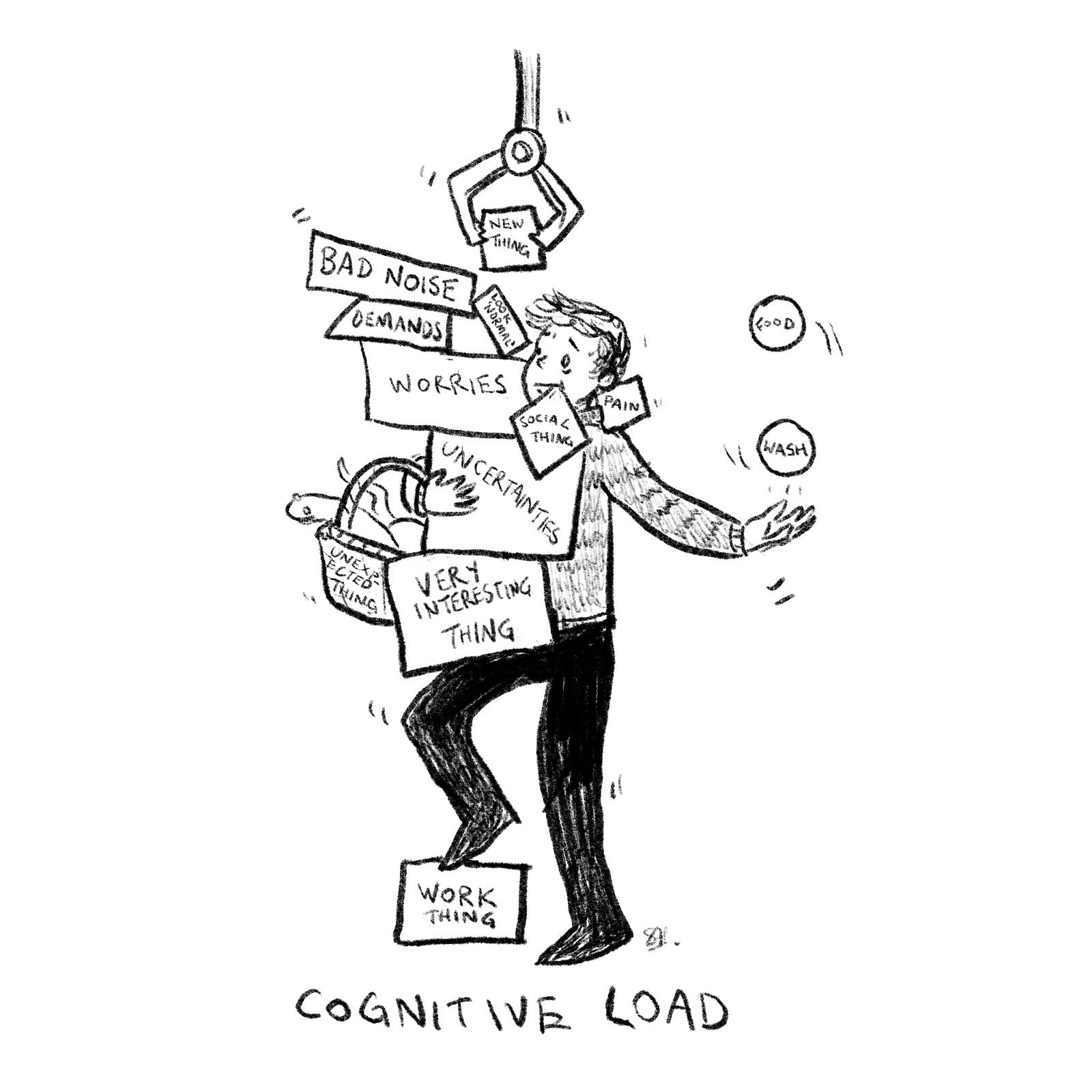
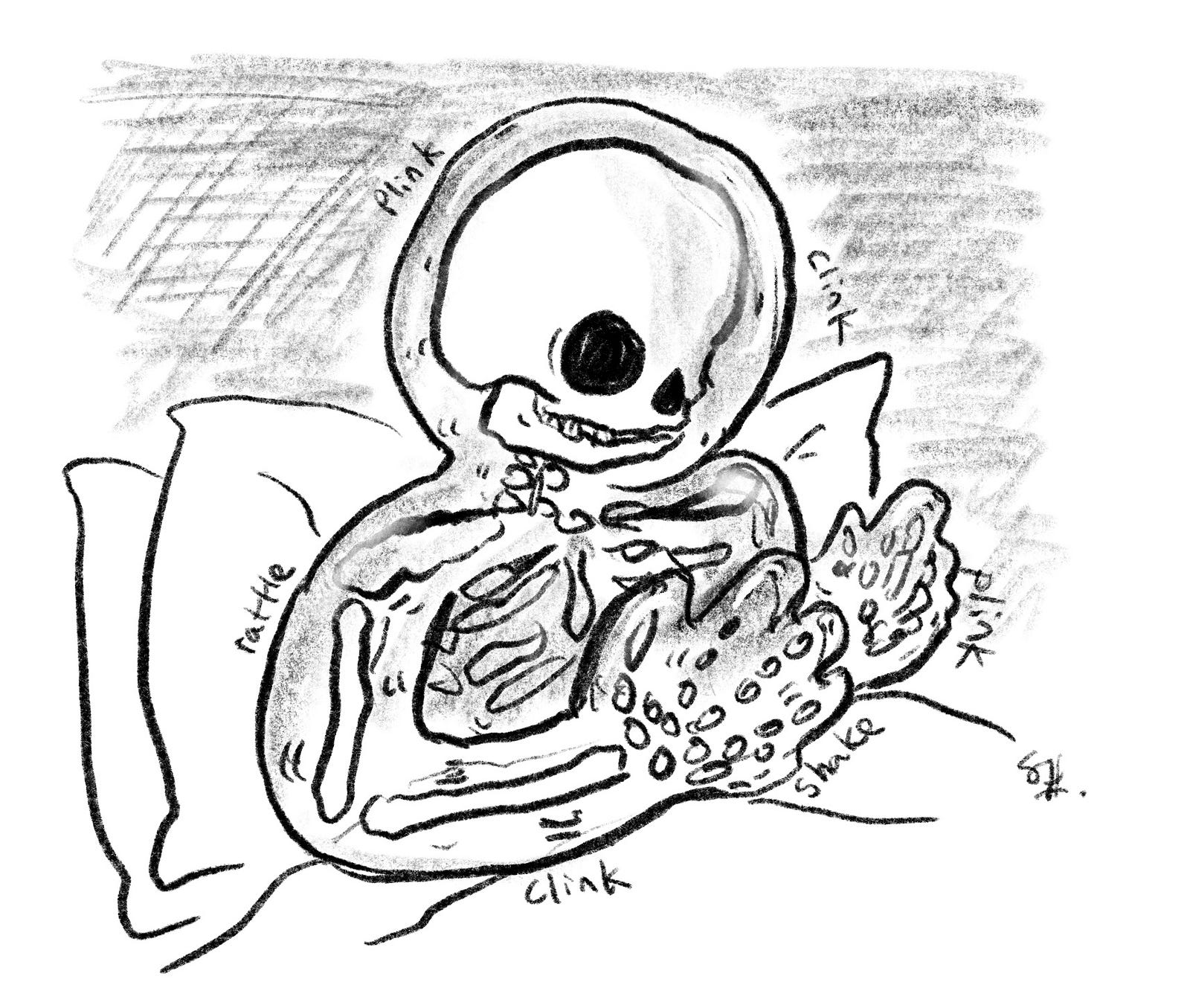
![separated by a long diamond. In the first section is a drawing of a white palm. The section is captioned “My edges feel fuzzy, like I’m drifting apart.” The second panel has a drawing of the same hand in a first. It is captioned, “Perhaps that’s partly why…” The third panel contains a drawing of a fist slamming into the bottom of the square, cracking the surface below it. Above the first is a large, a jagged semi-circle, showing that the fist was slammed down with great force. The caption finishes, “…I feel like I need to SLAM them back into place. In full, the caption reads, “My edges feel fuzzy, like I’m rifting apart. Perhaps that’s partly why… …I feel like I need to SLAM them back into place.”]](https://cdn-images-1.medium.com/max/1600/1*GkDoE4ytjPr6CBP0rHzebw.jpeg)
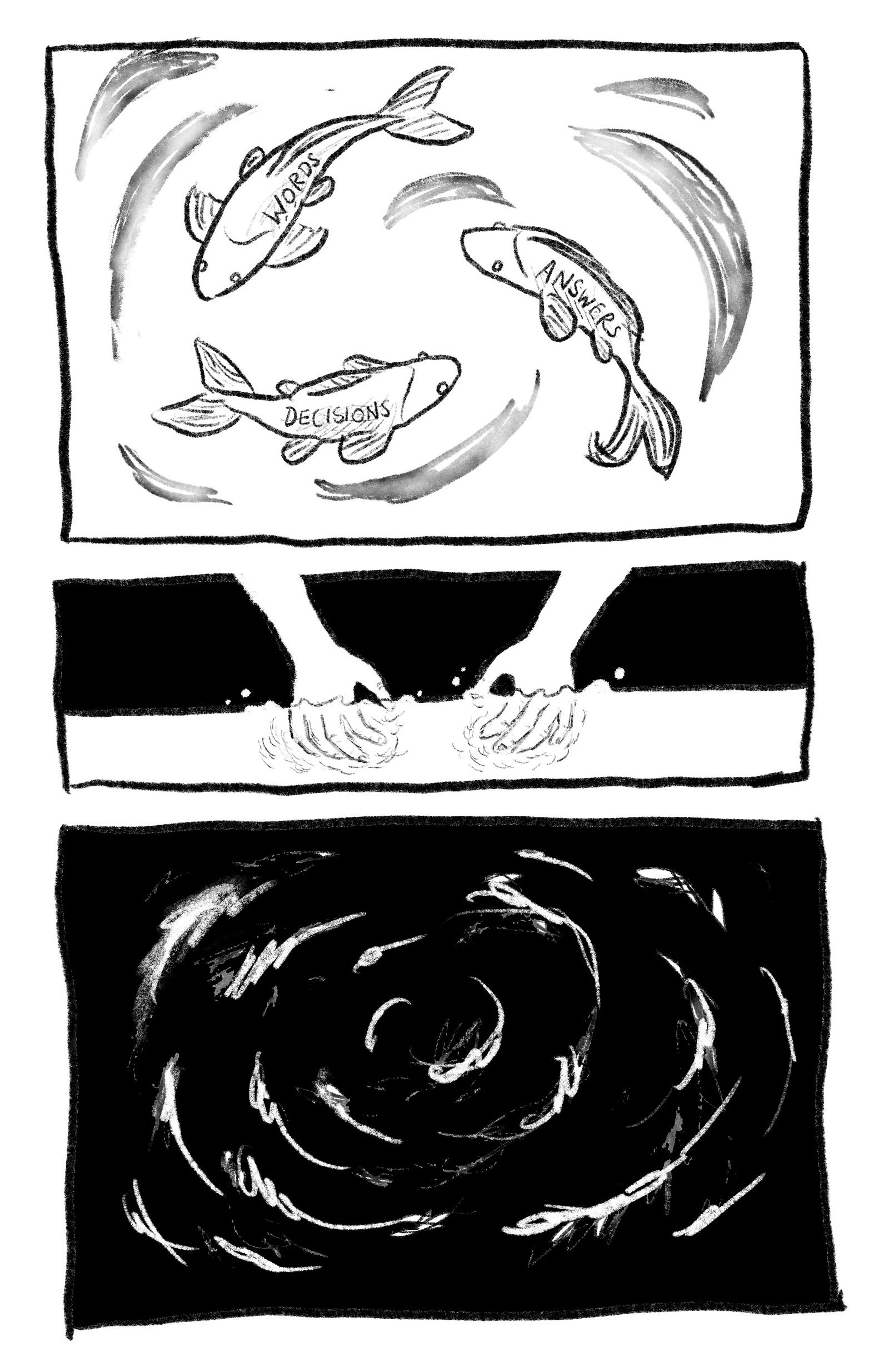
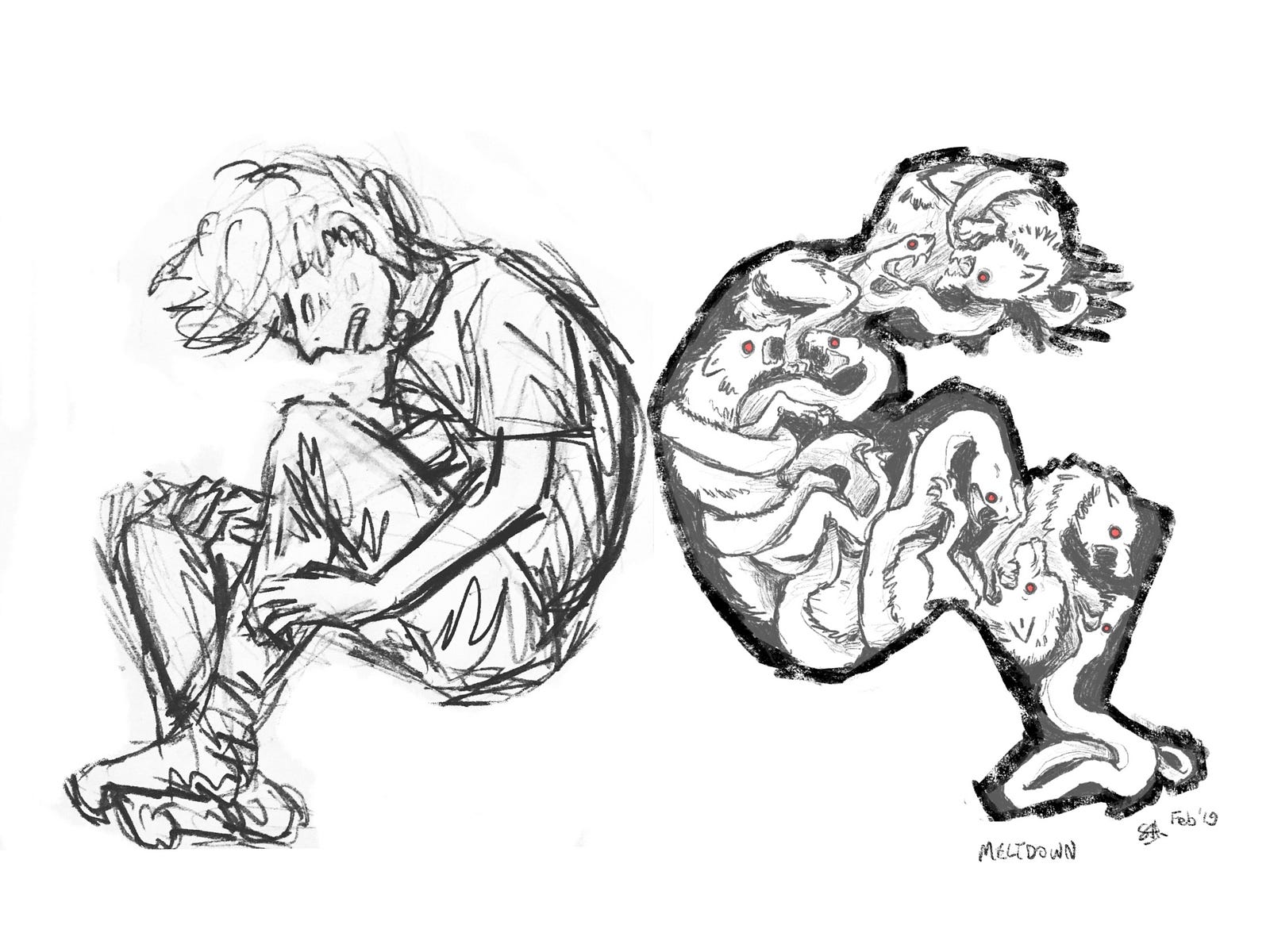



0 comments:
Post a Comment